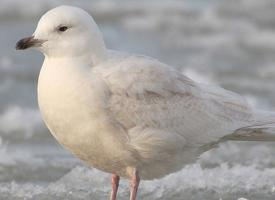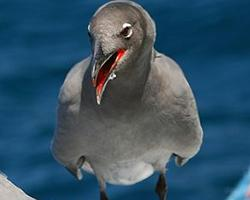
Váhy a míry
| Délka | od 25 do 27 cm |
|---|---|
| Délka rozpětí křídel | od 75 do 80 cm |
Stav ohrožení
| Ohrožen |
Popis zvířete
The Little gull (Hydrocoloeus minutus), a member of the Laridae family, is the smallest species within the gull family and is easily distinguished by its delicate and diminutive stature. It has a wingspan of approximately 61-67 centimeters (24-26 inches), and a body length ranging from 25 to 30 centimeters (9.8-11.8 inches), with an average weight of 68 to 162 grams (2.4-5.7 ounces). This petite gull possesses a combination of physical and behavioral traits that make it unique among its larger relatives.One of the most striking features of the Little gull is its plumage. During the breeding season, adults exhibit a striking black hood, which contrasts sharply with their pale grey upperparts and white underparts. The wings are also pale grey, but with a distinctive feature: the underwings are a pure, bright white with a distinctive black leading edge that is visible in flight. This contrast is particularly noticeable and is often used as a key field mark to identify the species. In the non-breeding season, the black hood recedes, leaving a smudged grey patch on the head, while the rest of the body maintains its pale grey and white hues.
The Little gull's bill is short and slender, typically colored a dark red, which can fade to a blackish hue outside of the breeding season. Its legs are also red, providing a splash of color that stands out against its lighter body. The bird's eyes are dark, surrounded by a narrow white ring that adds to its delicate appearance.
These gulls are highly adapted to life on the wing, displaying agile and buoyant flight. They often feed by picking food off the water's surface as they fly, a behavior known as "dipping," rather than the more robust diving techniques of larger gulls. Their diet mainly consists of small fish, insects, and crustaceans. They are opportunistic feeders and may also scavenge at times.
Little gulls breed in colonies on freshwater marshes, lakes, and rivers across northern Europe and Asia. They prefer to nest on the ground, often choosing spots with ample vegetation to provide some cover. Their nests are relatively simple structures, often little more than a scrape in the ground lined with plant material.
During the winter months, Little gulls migrate to coastal areas, where they can be found in sheltered bays and estuaries. Some travel as far as the coastal regions of western Europe and the Mediterranean, while others may venture to the eastern coasts of North America.
The Little gull's social behavior is typical of gulls, with strong communal bonds formed during the breeding season. They engage in elaborate courtship displays that include calls and aerial acrobatics. Outside of the breeding season, they can often be seen in flocks, sometimes mixing with other gull species.
Conservation-wise, the Little gull is considered to be of Least Concern by the International Union for Conservation of Nature (IUCN), although local populations may be affected by habitat destruction and environmental pollution. Efforts to protect their breeding and feeding grounds are essential to ensure the continued survival of these charming and unique birds.
Podobná zvířata
Nové fotografie zvířat
Top 10 zvířat
- Dolphin gull (Leucophaeus scoresbii)
- Diana monkey (Cercopithecus diana)
- Moustached guenon (Cercopithecus cephus)
- Galápagos tortoise (Geochelone nigra complex)
- Russian tortoise (Testudo horsfieldii)
- Japanese macaque (Macaca fuscata)
- Stone loach (Barbatula barbatula)
- Greek tortoise (Testudo graeca)
- Common flying dragon (Draco volans)
- Colossal squid (Mesonychoteuthis hamiltoni)


